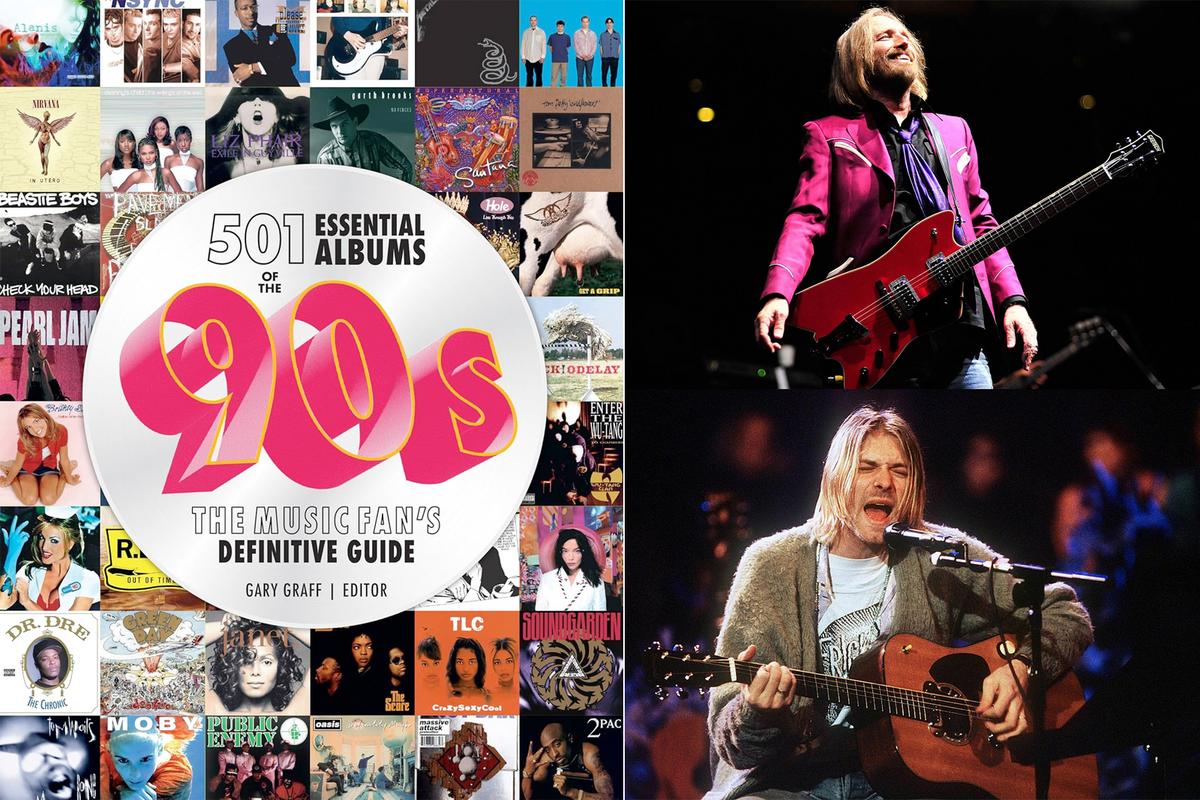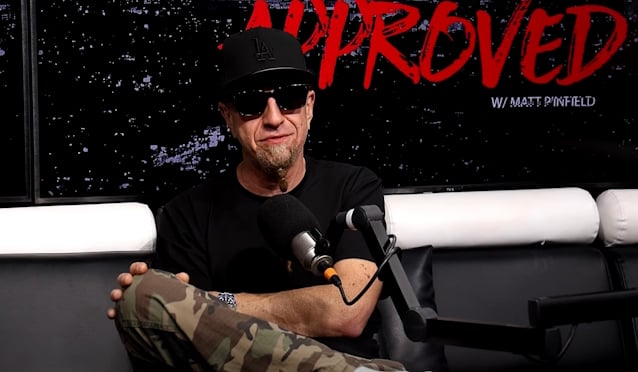Break out your flannel, scrunchies and high-rise jeans, because it’s time to revisit the ’90s with the new book 501 Essential Albums of the ’90s: The Music Fan’s Definitive Guide.Featuring contributions from Ultimate Classic Rock team members Michael Gallucci, Matthew Wilkening and book editor Gary Graff, 501 Essential Albums of the ’90s is designed both to inform and to start arguments.The exclusive excerpt below features the book’s descriptions of 10 of the most essential rock albums of 1994, featuring Tom Petty, Nirvana, Soundgarden and more.With lively descriptions of the releases and over 600 images, this hefty 448-page volume curates 501 albums spanning genres and subgenres— including pop, hip-hop, R&B, grunge, metal, country and world music. Graff has assembled a team of experienced music journalists to detail the circumstances of each release, highlight notable singles and discuss their influence on contemporary and later artists.501 Essential Albums of the ’90s is available now from Amazon and all other major retailers. You can also enter to win one of five free copies of the book below.Soundgarden, SuperunknownA&M | Producers: Michael Beinhorn, Soundgarden Released: March 8, 1994With Superunknown, Soundgarden hit the mainstream and hit it hard. The Seattle band’s fourth album debuted at No. 1 on the Billboard 200, went six-times platinum, and spawned five singles that went on to dominate the US Alternative Airplay and Mainstream Rock charts. Most notable among those, of course, was “Black Hole Sun,” a trippy yet heavy-hitting track with an even trippier video that became an MTV staple back when that still meant something.Perhaps Superunknown was simply the right album at the right time. Pearl Jam’s Ten and Nirvana’s Nevermind had softened the ground that later nurtured hit albums such as Alice in Chains’ Dirt, Stone Temple Pilots’ Purple, and Hole’s Live through This. Trends aside, bythe time of Superunknown, Soundgarden had reached a level of musical maturity that made its songwriting simultaneously more sophisticated (check some of those crazy time signatures), more melodic, and more accessible.The quartet’s obvious classic rock antecedents, including The Beatles and Led Zeppelin, were plainly evident in songs such as “Head Down,” “Half,” “Black Hole Sun” and others, though the Zep comparison especially was anathema to frontman Chris Cornell, who abhorred hard rock’s toxic machismo. But while the album’s radio-ready sound struck a chord with the masses, Superunknown hardly presented a kinder, gentler Soundgarden. Themes of apocalypse, alienation (a grunge given), and suicide—chilling, given Cornell’s eventual self-determined demise—dominate the lyrics. At the time, Cornell dismissed the latter reading as too literal; “Let Me Drown,” he admitted, was “one of the most disturbing songs I’ve ever written. It made me question whether it was a song that was alright to play.” But others, he maintained, were “like watching a horror movie; it makes you feel better after feeling worse.” (Daniel Durchholz)Oasis, Definitely MaybeCreation | Producers: Owen Morris, Mark Coyle, Noel GallagherReleased: August 29, 1994Technically, the members of Oasis weren’t yet rock stars when Definitely Maybe was released. But the album is a declaration, the sound of the group willing itself into the spotlight. “Toniiiiiiiiight, I’m a rock ’n’ roll star,” Liam Gallagher wails on the opening track. You gonna tell him he’s not? Definitely Maybe introduced the world to the forever feuding Gallagher brothers—Liam and songwriter/guitarist Noel, his big brother—a pair of working-class lads from Manchester, England, who took on the globe even as they warred with each other. Guitarist Paul “Bonehead” Arthurs, bassist Paul “Guigsy” McGuigan, and drummer Tony McCarroll rounded out the line-up, though the non-Gallagher personnel would shift throughout the band’s existence.Definitely Maybe was full of loud guitars, sneering attitude, and several metric tons of swagger. Forget introspection—Oasis was chasing immortality, and the group found it in “Live Forever,” a bulletproof rocker for the ages about not being beholden to the limits of time or space. “You and I are gonna live forever,” the chorus goes, and it makes you think that band just might. Everything is mega and anything is possible on Definitely Maybe; the trick is the nuggets of encouragement baked into the booze-soaked psalms. “I’m feeling supersonic, give me gin & tonic,” Liam sang on “Supersonic.”Later, on the squealing, hedonistic “Cigarettes & Alcohol,” he comes on like a motivational speaker, turning a song about overindulgence into an anthem for self-starters. As the Britpop movement it helped usher in took flight, the band’s dreams of superstardom were made whole when Oasis headlined Britain’s Glastonbury Festival the year after Definitely Maybe’s release. Then again, was there ever a doubt it would? Then and forever more, Oasis’s members are rock ’n’ roll stars. (Adam Graham)Tom Petty, WildflowersWarner Bros. | Producers: Rick Rubin, Tom Petty, Mike Campbell Released: Nov. 1, 1994Tom Petty stepped outside of the Heartbreakers to make a solo album with 1989’s Full Moon Fever and, in the process, scored one of the most successful albums of his career. He repeated that feat five years later with Wildflowers, a fifteen-song collection that shows Petty at the peak of his songwriting powers. The album’s enduring legacy—some justifiably consider it Petty’s all-time best—owes much to the diversity of the songs. It was originally conceived as a double album, but by winnowing it to a single disc (albeit a CD size sixty-three minutes, the remainder of which would surface on a 2021 box set), it displayed a range of winsome acoustic ballads, up-tempo rockers, moody diversions, and points in between.The title track and album opener, for instance, is classic Petty, strumming an acoustic guitar and perhaps telegraphing his own emotions as he declares, “You belong somewhere you feel free.” The rocking “You Wreck Me,” one of two tracks co-written with Heartbreakers guitarist and Wildflowers co-producer Mike Campbell, became a concert staple for the band, as did the single “You Don’t Know How It Feels,” which raised eyebrows with the controversial (for 1994, at least) chorus line about rolling another joint.The dueling finger-picked acoustic guitars on “Don’t Fade on Me” showcase how instinctually synced Petty and Campbell were musically. “It’s Good to Be King,” meanwhile, features excellent keyboard work from the Heartbreakers’ Benmont Tench, and the album-closing “Wake Up Time” offers a rare moment of Petty on piano.All of the Heartbreakers play on the album, along with an assortment of guests, including Ringo Starr and the Beach Boys’ Carl Wilson, but Wildflowers is unquestionably one man’s deep and heartfelt expression, rendered with an exquisite sincerity that holds its own alongside any of the legendary singer/songwriter classics that came before it. (Steve Taylor)Nine Inch Nails, The Downward SpiralNothing / Interscope | Producers: Trent Reznor, Flood Released: March 8, 1994With Nine Inch Nails’ 1989 debut album, Pretty Hate Machine, Trent Reznor proved that industrial music could have a place in the mainstream if it played by some of pop’s old rules. By instilling melody and traditional verse-chorus-verse structures to industrial rattles and clangs, virtual one-man band Reznor had a hit on his hands, eventually selling more than three million copies of an independently released record from a genre that rarely peeked out of the underground. For Nine Inch Nails’ follow-up LP, he aimed bigger.A sixty-five-minute concept album about one man’s mental breakdown, The Downward Spiral perfectly captured the ethos of the flourishing alt-rock movement of the mid-’90s. Dark, despairing, and filled with loud, aggressive music that wore its bruised heart on its sleeve, the fourteen-track album was a critical work during what was arguably the biggest year for the alt-rock nation. Adding to its legend, the album was recorded in the house where the Manson Family murdered actress Sharon Tate and others during the summer of 1969. The result was an album of harrowing imagery, abrasive sounds, and lyrical themes that encompassed complete hopelessness. The Downward Spiral, with its unflinching look at depression and suicide, somehow became a commercial juggernaut. It peaked at No. 2, went four-times platinum, and featured a handful of radio hits, including “Closer,” a widely misinterpreted song about self-hate. And then there was “Hurt,” a six-minute track that brought The Downward Spiral to its drawn conclusion.The slow-building ballad, whose industrial buzzes underlie an irresistible pop chorus, was covered by Johnny Cash and served as a requiem to his long career. The Downward Spiral had that much reach. (Michael Gallucci)Nirvana, MTV Unplugged in New YorkDGC | Producers: Alex Coletti, Scott Litt, Nirvana Released: Nov. 1, 1994Nirvana was one of the biggest bands on the planet when it performed a set for MTV’s popular Unplugged series during November 1993. The group had followed its landmark 1991 album Nevermind with the raw and uncompromising In Utero in 1993. Two months after the second album’s release (and its debut at No. 1), Kurt Cobain, Krist Novoselic, Dave Grohl, and touring guitarist Pat Smear performed an hour-long set at New York’s Sony Music Studios with help from cellist Lori Goldston and Meat Puppets members Cris and Curt Kirkwood.Instead of playing the best-known songs from its two hit albums, Nirvana filled its setlist with deep cuts: covers of David Bowie (“The Man Who Sold the World”), the Vaselines (“Jesus Doesn’t Want Me for a Sunbeam”), and Lead Belly (“Where Did You Sleep Last Night”), plus three Meat Puppets favorites. It was a revelatory performance, a stripped-down antidote to the blistering abrasion of In Utero. The program aired on December 16, 1993; four months later, Cobain died from a self-inflicted gunshot wound. When MTV Unplugged in New York arrived as an album in November 1994, it served as a requiem for the late Nirvana leader and a memorial to his legacy. (Michael Gallucci)Jimmy Page and Robert Plant, No Quarter: Jimmy Page and Robert Plant UnleddedAtlantic| Producers: Jimmy Page, Robert Plant Released: Oct. 31, 1994Two Led Zeppelin reunions had been dissatisfying on many fronts, making the possibility of more seem remote. But when MTV reached out with an idea for one of its Unplugged episodes, Jimmy Page and Robert Plant were game. “Forgetting” Zep mate John Paul Jones’s phone number, the two reunited for this ambitious troll through the Zep catalog, plus four new songs, accompanied by expanded instrumentation (mandolin, bodhran, hurdy-gurdy, banjo) and an eleven-member ensemble.The results were revelatory, from Blind Willie Johnson’s “Nobody’s Fault but Mine,” slowed considerably from the slamming version on Presence in 1976, and peaking with an epic “Kashmir” that sounded even more in tune with the Vale of Kashmir than its 1975 original. Both men were clearly comfortable and invigorated by these new sonic surroundings (which weren’t completely unplugged, of course), and the new tracks fit well enough to suggest a future was at hand. Page and Plant managed to tour and release a new studio album, 1998’s Walking into Clarksdale, before pulling the curtain on this chapter. (Gary Graff)Melvins, Stoner WitchAtlantic | Producers: Melvins, GGGarthReleased: Oct. 18, 1994Of all the Seattle-area bands signed to major labels during the post-Nirvana gold rush, Melvins may have been the most influential and deserving. Naturally, it also probably benefited the least. Still, we got three great records out of the trio’s Atlantic Records years, and Stoner Witch, home to perhaps the closest thing Buzz Osbourne and Dale Crover have ever had to a hit in “Revolve,” still makes a great jumping-on point for anyone curious about the group. And let’s be clear, you should hear everything you possibly can from these ever-inventive, constantly evolving hard rock geniuses. (Matthew Wilkening)Green Day, DookieReprise | Producers: Rob Cavallo, Green DayReleased: Feb. 1, 1994When Green Day titled its third album and major label debut Dookie, the young punks must have been pretty confident it wasn’t a piece of you-know-what. They were, and it wasn’t. You can just imagine the scatological reviews that would have followed otherwise. Dookie may have seemed like a load of whiny brattiness to the old Clash fans, but for a segment of a restless Gen X it captured real, everyday life in a raw, game-changing, genre-defining pop-punk package. While Nirvana was up the coast brooding rather opaquely about boredom and apathy, the Berkeley, California, trio was laying it out there in plain English and having a blast doing it, starting with the opening line “I declare that I don’t care no more!” And what kid couldn’t relate to this classic verse from the breakout single “Longview”: “I sit around and watch the phone/But no one’s calling/ Call me pathetic, call me what you will/My mother says to get a job/But she don’t like the one she’s got/When masturbation’s lost its fun, you’re f*cking lazy.” Under the helm of producer Rob Cavallo, the poppunk goodness is darn-near relentless on Dookie, which spawned four more singles: the hyper, panic-driven “Basket Case”; the more amped-up “Welcome to Paradise” (originally on 1991’s Kerplunk!); “She,” inspired by a feminist poem an ex showed to frontman Billie Joe Armstrong; and “When I Come Around,” a lurching mid-tempo anthem about a boy who won’t be tied down. Dookie shot to No. 2 on the Billboard 200, sold more than twenty million copies worldwide, won a Grammy Award, propelled the group to Woodstock ’94, topped Rolling Stone’s 50 Greatest Pop-Punk Albums list, and established Green Day as the premier band in a genre ready to explode. (Scott Mervis)Pearl Jam, VitalogyEpic | Producers: Brendan O’Brien, Pearl Jam Released: Nov. 22, 1994Having positioned itself among the leaders of the grunge revolution, Pearl Jam got weird on its third album. The classic rock and punk influences that ran through its first two records were still present, but, firmly settled on top of the commercial mountain, the Seattle five-piece revealed its experimental side while still giving fans the gnarly guitars and Eddie Vedder’s anguished howls that made Ten and Vs. such monster hits. In some ways, Vitalogy was Pearl Jam’s reaction to that success. The album was mostly written and recorded on tour, allowing the band to indulge in its most primal urges as it pieced together tracks that rarely sounded like they belonged on the same record. “Bugs,” for instance, was spoken-word rambling over a single repeated accordion riff. “Aye Davanita” broke things down further to a wordless chant, and “Stupid Mop,” a seven and-a-half-minute sound collage that must have confused the hell out of “Even Flow” lovers, dispensed with the music altogether. Still, Vitalogy debuted at No. 1 and went five-times platinum: “Not for You,” “Corduroy,” and “Better Man” were all radio hits not too far removed from the expectations Pearl Jam was quickly shedding. (Michael Gallucci)Stone Temple Pilots, PurpleAtlantic | Producer: Brendan O’BrienReleased: June 7, 1994Stone Temple Pilots’ (STP) first album, Core, was a hit with the record-buying public but trashed by most critics, the general complaint being that it was generic, copycat grunge. The quartet held the singular distinction of being named Best Band of 1994 by Rolling Stone readers and Worst Band of 1994 by the magazine’s critics. Whether it was a desire to silence those cynics or just flex its musical muscles, STP expanded its sonic palette for its second release.On Purple, the band injected elements of blues, jazz, country, funk, and folk into its songwriting and performance while staying true to the grungey rock roots of Core. This expanded musical direction was particularly showcased on the track “Lounge Fly,” which opened with psychedelic guitar, moved to a funky verse akin to the Red Hot Chili Peppers, then shifted to a rock anthem chorus followed by a soft acoustic guitar bridge before grinding to the finish. “Interstate Love Song” was as at home on a Texas roadhouse jukebox as it was on arena stages, and “Big Empty” started with jazzy chords and vocals before hitting its rocking, singalong chorus. The experiment not only worked artistically but paid off big as Purple debuted at No. 1 on the Billboard 200 chart, where it stayed for three weeks, eventually selling more than six million copies. “Vasoline” and “Interstate Love Song” were both No. 1 Mainstream Rock chart hits and No. 2 on Alternative Airplay. Purple also made some of 1994’s best albums lists, achieving the rare feat of converting detractors into believers while keeping its core audience happy. (Gary Plochinski)Top 30 American Classic Rock Bands of the ’90s







